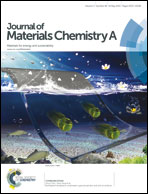High performance H2 evolution realized in 20 μm-thin silicon nanostructured photocathodes†
Abstract
Thickness reduction in high-purity silicon wafers is beneficial for cost-efficient hydrogen evolution utilizing silicon photocathodes. However, two major issues need to be resolved: insufficient light absorption by a thin Si absorber and poor charge transfer reaction by dominant surface recombination. Here, we present 20 μm-thin Si photocathodes employing Pt-nanoparticle-coated silicon nanoholes that realize a photocurrent of 23 mA cm−2 (at 0 V vs. RHE) corresponding to the amount typically achieved by a conventional wafer (∼200 μm-thick).


 Please wait while we load your content...
Please wait while we load your content...